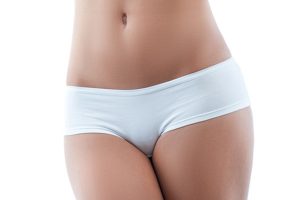
Labiaplasty is a surgical procedure that reduces elongated and protruding labia minora. The procedure addresses both aesthetic and functional difficulties that women with prominent vaginal lips often struggle with. Women seeking labiaplasty typically experience embarrassment, pain, or irritation when sitting, during sexual activities, or wearing fitted clothing.
Just a decade ago, it wasn’t common knowledge that there is a procedure specifically designed to address the aesthetic contour of the tissue surrounding the opening of the vagina, the labia minora. Women may have dealt with embarrassment or discomfort in silence, not knowing there was a solution. But, from 2012 to 2017, requests for labiaplasty skyrocketed by 217%! [1]
Dr. Michael J. Yoo and his staff are dedicated to creating a safe space where women can learn more about this confidence-boosting and life-changing procedure so they can make an informed decision. To see if labiaplasty is right for you, schedule a personal consultation by calling our Newport Beach office at (949) 861-3340 or (424) 209-9925 to contact our Beverly Hills office. You can also fill out our online form, and our staff will be in touch with you shortly.
Contents
About
Labiaplasty is a procedure that alleviates both physical and emotional discomfort by reshaping one or both of the labia minora. Labial hypertrophy, or enlarged, elongated labia minora, can be a congenital condition or a result of puberty or childbirth. [1] Labial hypertrophy can cause friction and discomfort, and visibly overdeveloped labia can cause emotional distress.
Labiaplasty can enhance the overall aesthetic of the vaginal region and help restore a woman’s self-esteem and confidence. A clinical study found that more than 97% of women who underwent labiaplasty were satisfied with their results. [2]
Labiaplasty Techniques
There are different labiaplasty techniques that can be performed to address enlarged labia. Dr. Yoo will assess the patient’s condition during the consultation and determine which technique will provide optimal results.
Trim (Edge) Resection
The trim resection excises the edges of the labia minora that hang over the labia majora, or the outer vaginal lips. The tissue is excised either with a scalpel or laser. Both techniques are quick and effective, removing the protruding or irregular tissue to create the desired results. This method is usually recommended for women who have dark pigmentation on the edges of the labia minora, uneven outer edges, or thick labial tissue that they would like to eliminate. [1]
Wedge Resection
The wedge resection removes a wedge-shaped piece of tissue from the middle of the labia minora and sutures the top and bottom thirds together. This technique is recommended for women who struggle with excess labia minora tissue but do not have issues with the labial edges. This technique preserves the natural shape and color of the labial edges and places less stress on the sutures. [1]
Central (Extended) Wedge Resection
The central wedge resection is a modified version of the wedge resection technique. It takes a wedge-shaped piece from the inside of the labia minora, as well as a downward-facing wedge that curves laterally and anteriorly along the upper external edge of the labia minora. This makes it so the scar is concealed vertically within the crease between the inner and outer labia. The central wedge resection technique also makes it easier to perform clitoral hood reduction if desired, since the incision already runs toward the clitoris. [3]
Clitoral Hood Reduction
Clitoral hood reduction is a procedure that reduces the tissue surrounding the clitoris, which extends to transition into the labia minora. This is accomplished by excising lateral hood tissue and/or repositioning the clitoris inward and anterior. Since the clitoris and labia tissue is one unit, performing a labiaplasty without a clitoral hood reduction has been equated to getting a lower facelift without a neck lift. When reducing the size of the labia minora, it is best to also reduce the clitoral hood so the results are well-proportioned. [1]
Before & After Photos

Benefits
There are many emotional and physical benefits of labiaplasty, all of which allow a woman to enjoy her daily life more comfortably.
- Ability to wear tight pants and enjoy a wider range of lingerie and bathing suits without rubbing or the fear of “falling out.”
- More confidence and body positivity during intimacy
- Improved comfort when sitting or exercising
- Ability to enjoy cycling comfortably
- Reduced irritations and infections
- Better access and stimulation of the clitoris during sex
Nobody “needs” a labiaplasty, but if labial hypertrophy is physically or emotionally bothersome, we recommend seeking treatment. Labia come in all shapes and sizes, and there is also no such thing as a “perfect labia,” but Dr. Yoo listens closely to each patient’s goals to devise a surgical plan that will provide labia that they find aesthetically pleasing, and neatly fit the patient’s unique body and contours. Labiaplasty is a surgical procedure, so the decision shouldn’t be made lightly. But as long as the patient fully understands the rewards and risks, their decision to have labiaplasty can prove incredibly beneficial. In fact, a recent study of women that had undergone labiaplasty reported significant improvements in their satisfaction with their genital appearance, their self-confidence, and their sex lives!(2)
Candidates
Ideal candidates for labiaplasty are women who are in good health but experience discomfort from labial hypertrophy. Labial hypertrophy can be the result genetics, or hormonal changes during puberty, pregnancy and childbirth, as well as the aging process.
Common reasons for undergoing labiaplasty include:
- Asymmetry
- Friction
- Discomfort wearing fitted pants
- Discolored labial edges
- Painful sexual intercourse
- Discomfort when performing physical activities like bike riding
- Decreased clitoral stimulation
- Difficulties maintaining proper hygiene
Personal Consultation
During a personal consultation with board-certified plastic surgeon Dr. Michael J. Yoo, patients will have the opportunity to share their emotional distress or physical irritations caused by labial hypertrophy. At this time he will perform an examination and, if the patient is deemed a good candidate, he will create a personalized treatment plan that will provide the patient with optimal results. Any and all questions are encouraged; we want to ensure all patients are comfortable with their decision and fully informed of the procedure process and what to expect during their recovery.
Preparation
Each patient will receive personalized preparation instructions, but pre-operative instructions generally include:
- Stop smoking four to six weeks before the procedure; nicotine can negatively affect recovery.
- Do not take anti-inflammatory drugs or herbal supplements not prescribed by Dr. Yoo the month before surgery.
- Pick up any medications Dr. Yoo prescribes before the procedure; patients may need to take some of these medications prior to and immediately after surgery.
- Arrange for a ride home after the procedure; patients cannot drive themselves.
- Please shave the area on the day of surgery.
Procedure

Labiaplasty can take anywhere between 1.5 to 3.5hrs depending on the technique and procedures performed. The surgery can be performed under local or general anesthesia; this will be decided during the consultation. Some patients wish to avoid the risks associated with general anesthesia, and opt for local anesthetic, while others prefer not to be awake during their procedure. Dr. Yoo will begin by cleaning the treatment area and marking the excision locations. The anesthesiologist will then administer the agreed-upon anesthetic and, once anesthetized, the labia tissue will be excised according to the surgical technique deemed most suitable, and agreed upon during the consultation. Labiaplasty is a delicate procedure, and Dr. Yoo is very careful not to remove too much tissue. This can cause the labia minora to be too small or form a fistula: and opening in the suture lines. He is highly skilled in removing just enough tissue to achieve optimal aesthetic results and maintaining functionality. Closure techniques have improved to reduce fistula risk and postoperative pain.
Recovery
Patients will be able to walk right after their surgery, but they may want to take about a week off from work to speed up the healing process. It is recommended to lie down as much as possible during recovery. Swelling and tenderness are normal post-surgical symptoms and will subside in one to two weeks; ice packs and prescribed medication can help reduce discomfort. Patients should wear loose-fitting clothing for a few weeks or until it is comfortable to wear fitted pants; this transition should not be rushed. Prescribed antibiotics and lubricants should be applied to the treatment area as instructed.
Patients may shower 24 hours after the procedure with gentle, non-irritating soap, making sure to avoid rubbing or pulling on the incisions. Pools and hot tubs should be avoided until fully healed. Dr. Yoo will provide patients with a syringe that they can fill with water and clean the treatment area. Do not use tampons, engage in sexual intercourse, or perform activities that cause friction in the treatment area, including horseback riding, cycling, or riding a motorcycle for at least two months or until instructed.
You can learn more about labiaplasty postoperative healing on our blog.
Results
The goal of labiaplasty is to provide each patient with their desired outcome, so each surgery produces different results. Patients can expect to have a neater appearance with the majority, if not all, of the labia minora tissue concealed within the labia majora. Results from labiaplasty surgery are long-lasting. However, occurrences like vaginal childbirth, aging, or trauma can affect results.
Corresponding & Complementary Procedures
Labiaplasty is a procedure that can be performed alone but it is also commonly performed during a Mommy Makeover. A Mommy Makeover combines different body and breast procedures to enhance and restore the figures of women, typically after childbirth. Hormonal changes from pregnancy and tearing during vaginal childbirth are common motivations for including a labiaplasty in a Mommy Makeover.
How Much Does a Labiaplasty Cost in Newport Beach?
The cost of labiaplasty depends on the individual case, the type of anesthesia used, and whether the patient opts to undergo additional body-enhancing procedures. Dr. Yoo provides patients with an individualized quote during the consultation. We now accept Care Credit and Alphaeon.
FAQ
What are the risks of labiaplasty?
Overall, complications from labiaplasty are not common. However, as with any surgical procedure, there are some potential risks associated with labiaplasty. Labiaplasty may cause pain, bleeding, scarring, swelling, or a change in sensation. The trim resection method runs the risk of results not looking natural since the edges of the labia minora are uneven by nature. Straight scars also have the potential of tightening and stiffening. If not properly taken care of, wedge resection suturing can potentially not hold and cause a gap in the labia, requiring a second surgery. Laser labiaplasty runs the risk of nerve damage or loss of sensation.
For these reasons, it is incredibly important to go to a plastic surgeon who is well-experienced in the procedure, such as Dr. Yoo. He will do everything in his power to provide the patient with optimal results in the safest way possible.
Why is labiaplasty performed?
The majority of patients seek labiaplasty to decrease the outward protrusion of their labia minora, and improve their physical and emotional comfort.
How long does labiaplasty take to perform?
The length of labiaplasty surgery varies based on an individual’s anatomy and goals. Surgical time can be as short as 45 minutes and up to three hours depending on these factors.
Does labiaplasty leave visible scars?
Scar quality is largely genetic-based and varies from person to person. But scars on the labia tissue tend to be very thin to nearly unnoticeable. The quality of the scars also depends significantly on how one cares for the incisions postoperatively. Detailed instructions will be provided at your consultation.
References
- Willis RN, Wong CS, Pai A, Patel BC. Labiaplasty Minora Reduction. PubMed. Published 2021. Accessed October 15, 2022. https://www.ncbi.nlm.nih.gov/books/NBK448086/
- Sharp G, Tiggemann M, Mattiske J. A Retrospective Study of the Psychological Outcomes of Labiaplasty. Aesthetic Surgery Journal. 2016;37(3):324-331. doi:10.1093/asj/sjw190
- Alter GJ. Aesthetic labia minora and clitoral hood reduction using extended central wedge resection. Plast Reconstr Surg. 2008;122(6):1780-1789. doi:10.1097/PRS.0b013e31818a9b25
